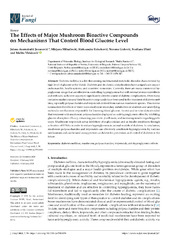Приказ основних података о документу
The Effects of Major Mushroom Bioactive Compounds on Mechanisms That Control Blood Glucose Level
| dc.creator | Arambašić Jovanović, Jelena | |
| dc.creator | Mihailović, Mirjana | |
| dc.creator | Uskoković, Aleksandra | |
| dc.creator | Grdović, Nevena | |
| dc.creator | Dinić, Svetlana | |
| dc.creator | Vidaković, Melita | |
| dc.date.accessioned | 2021-02-12T14:58:06Z | |
| dc.date.available | 2021-02-12T14:58:06Z | |
| dc.date.issued | 2021 | |
| dc.identifier.issn | 2309-608X | |
| dc.identifier.uri | https://www.mdpi.com/2309-608X/7/1/58 | |
| dc.identifier.uri | https://radar.ibiss.bg.ac.rs/handle/123456789/4141 | |
| dc.description.abstract | Diabetes mellitus is a life-threatening multifactorial metabolic disorder characterized by high level of glucose in the blood. Diabetes and its chronic complications have a significant impact on human life, health systems, and countries’ economies. Currently, there are many commercial hypoglycemic drugs that are effective in controlling hyperglycemia but with several serious side-effects and without a sufficient capacity to significantly alter the course of diabetic complications. Over many centuries mushrooms and their bioactive compounds have been used in the treatment of diabetes mellitus, especially polysaccharides and terpenoids derived from various mushroom species. This review summarizes the effects of these main mushroom secondary metabolites on diabetes and underlying molecular mechanisms responsible for lowering blood glucose. In vivo and in vitro data revealed that treatment with mushroom polysaccharides displayed an anti-hyperglycemic effect by inhibiting glucose absorption efficacy, enhancing pancreatic β-cell mass, and increasing insulin-signaling pathways. Mushroom terpenoids act as inhibitors of α-glucosidase and as insulin sensitizers through activation of PPARγ in order to reduce hyperglycemia in animal models of diabetes. In conclusion, mushroom polysaccharides and terpenoids can effectively ameliorate hyperglycemia by various mechanisms and can be used as supportive candidates for prevention and control of diabetes in the future. | |
| dc.publisher | MDPI AG | |
| dc.relation | info:eu-repo/grantAgreement/MESTD/inst-2020/200007/RS// | |
| dc.rights | openAccess | |
| dc.rights.uri | https://creativecommons.org/licenses/by/4.0/ | |
| dc.source | Journal of Fungi | |
| dc.subject | Anti-hyperglycemic effects | |
| dc.subject | Diabetes mellitus | |
| dc.subject | Mushroom | |
| dc.subject | Polysaccharides | |
| dc.subject | Terpenoids | |
| dc.title | The Effects of Major Mushroom Bioactive Compounds on Mechanisms That Control Blood Glucose Level | |
| dc.type | article | en |
| dc.rights.license | BY | |
| dcterms.abstract | Видаковић, Мелита; Aрамбашић Јовановић, Јелена; Михаиловић, Мирјана; Ускоковић, Aлександра; Грдовић, Невена; Динић, Светлана; | |
| dc.rights.holder | © 2021 by the authors. Licensee MDPI, Basel, Switzerland. | |
| dc.citation.issue | 1 | |
| dc.citation.volume | 7 | |
| dc.identifier.doi | 10.3390/jof7010058 | |
| dc.identifier.pmid | 33467194 | |
| dc.identifier.scopus | 2-s2.0-85099813331 | |
| dc.identifier.wos | 000610335800001 | |
| dc.citation.apa | Aramabašić Jovanović, J., Mihailović, M., Uskoković, A., Grdović, N., Dinić, S., & Vidaković, M. (2021). The Effects of Major Mushroom Bioactive Compounds on Mechanisms That Control Blood Glucose Level. Journal of Fungi, 7(1), 58. | |
| dc.citation.vancouver | Aramabašić Jovanović J, Mihailović M, Uskoković A, Grdović N, Dinić S, Vidaković M. The Effects of Major Mushroom Bioactive Compounds on Mechanisms That Control Blood Glucose Level. J Fungi. 2021;7(1):58. | |
| dc.citation.spage | 58 | |
| dc.type.version | publishedVersion | |
| dc.identifier.fulltext | https://radar.ibiss.bg.ac.rs/bitstream/id/8203/jof-07-00058-v2.pdf | |
| dc.citation.rank | M21 |

